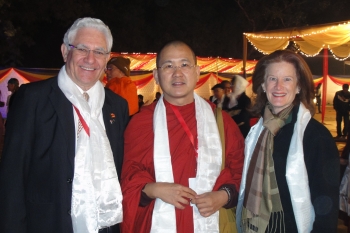We can see from the study of the Buddha’s earliest teachings in the vinaya-pi?aka, that he originally taught only dhamma necessary for the attainment of nibb?na. The dhammas such as the Four Noble Truths (catu ariyasacca), the Noble Eightfold Path (ariya a??hangika-magga), the Three Characteristics of Phenomena (tilakkhana dhamma), the Foundation of Mindfulness (satipatth?na), and the Seven Constituents of Enlightenment (satta bojjhanga) were helpful to those seeking his spiritual guidance to a noble path (ariya-magga). Many early disciples heard the teachings, rejoiced and were gradually ordained as bhikkhu-s by the Buddha with a simple formula, “ehi bhikkhu …” (Come! O monks…). At the very first ordination, the Buddha required only that his candidates practice the dhamma genuinely, and achieve attainment commensurate with their practice-levels.
When the Buddha began spreading dhamma he said: “open for those who have ears are the doors of immortality [the noble path]. Let them give up their wrong faith (saddh?).” (Hermann Oldenberg, ed. The Vinaya Pitakam (The Mahavagga), Vol. I (London: Published for the Pali Text Society by Luzac & Company, LTD., 1964), p.7.) He wanted his disciples to learn from the teachings and for society to grow prosperously and smoothly without any violation from moral precepts. He desired that mankind attain the ultimate goal, nibb?na in this very life. When the sangha of disciples had grown to the number of sixty-one members (including the Buddha himself), he qualified all those monks as missionaries and sent them in different directions to spread his message with a farewell blessing before departure:
“Go monks, travelling for the benevolence and blessings of many, for the happiness and welfare of many, out of compassion for the world, for Gods and humans; teach the dhamma which is lovely at the beginning, lovely in the middle, and lovely at the end. Do not go two of you on the same way”. (Hermann Oldenberg, ed. The Vinaya Pitakam (The Mahavagga), Vol. I (London: Published for the Pali Text Society by Luzac & Company, LTD., 1964), p.21.)
The early Buddhist sangha evolved into a religious and educational institution and the religious gatherings in turn gave birth to new social and political ideas and systems. The vinaya-pi?aka of 227 formal disciplinary rules and constitutional laws was established for monks and the lay community fully supported the superior moral example set forth by the sangha members. Even today, in most countries in Asia there is a strong reverence for the Buddha, the Dhamma, and the Sangha. The historical Buddha was a teacher of men and gods (satth?-deva-manuss?na?), and has always been highly valued for His exemplary morality (s?la), concentration (sam?dhi) and wisdom (paññ?).
Before passing away into parinibb?na, the Buddha wanted to ensure that there were capably trained monks, nuns, and male and female lay disciples who would confidently carry on the sublime dhamma. When Mara, the Evil One, asked him to die, the Buddha responded thus:
“O Evil One! I shall not pass away until my monks become erudite; and follow accordingly my teachings (dhamma), until they can teach and make known my sublime law (dhamma) to others and can confute any counter-teaching, and until my divine life is prosperous and widely spread and manifest by Gods and human beings”. (E.Hardy, ed. The Anguttara-Nikaya, Part IV (London: Published for the Pali Text Society by Luzac & Company, LTD., 1958), p. 310)
After 45 years of invaluable service to humanity and devas, the Buddha passed away.
The Buddhist sangha was initiated in ancient times to be the standard-bearer of the dhamma and lead and teach by example in order to help others along their path to understanding and enlightenment. In this way, we see that the active role of sangha community from past through to present, continues to be recognized for its valuable contribution to humankind. It upholds the virtue and preserves the importance of the Buddhist teachings, acting as a kind of paradigm of the ideal society.
The faster pace of modern life, economic downturns, and questions about traditional roles pose a few of the new challenges for both lay and monastic community members. Monks and nuns are adapting in their discipline of practice and interactions with lay communities that seem to need spiritual guidance more than ever. A commonly asked question today is what role does the sangha communities play in benefiting modern society? Offered below are a few suggestions for monks and nuns that honor both the traditional practices and adapt for application in today’s modern world:
(1). Forest & Cave Dwellers – some monks, nuns and laity may prefer the complete renunciation to stay away from the crowded places and dwell in quiet contemplation. It is only through the cultivation of mind that one can one purify his own mind for ultimate liberation. The best example is Ajahn Chah (1918-1992) who practiced in the style of an ascetic monk in the austere Forest Tradition. He spent time in forests, caves and cremation grounds; ideal places to develop meditation practice. Ajahn Chah’s simple yet profound style of teaching had a special appeal to Western practitioners, and many joined him for study and practice in the forest. They were inspired to become Buddhist monks and many carry own today his style of teaching.
There are also some nuns that have emerged after years of cave meditation to share their insight and knowledge for others. With our ease of international media today, their personal stories of secluded contemplation can be shared around the world for the benefit of many. For those that choose to spend full time in meditation for spiritual development, we hope that they return to share their wisdom to others who need guidance along the spiritual path.
(2). Academic Study & Research of dhamma-vinaya - there has been a tremendous upsurge of general interest in Buddhism, particularly in the West. We have seen a particular increase in academic studies around the world on the relationships between science and Buddhist teachings. Additionally, many ancient Buddhist teachings, original commentaries and sub-commentaries are still preserved intact in early texts and have not been thoroughly researched and translated into modern languages. This treasure of ancient knowledge can be revealed through academic research, supported by modern textual and study methodologies. The translations and body of researched materials can be published for the use of those interested in understanding Buddhism.
Many talented Buddhist monks and lay scholars have trained in classical languages and devoted their careers to the study of the canonical texts and commentaries. These individuals contributed a significant body of research and publication that enriches serious students of Buddhism. Previously, the traditional study of religious texts and commentaries was largely conducted in monasteries and specialized institutes.
Distinguished universities in the East as well as in the West, such as The University of Hong Kong, Harvard University, Stanford University and UBC Vancouver are sponsoring and hosting quality academic research centers for Buddhist studies. Coursework and academics are offered to both the serious researcher and the general public for propagating a better understanding of the value and application of Buddhist teachings.
(3). Applied Buddhism for Mental Calming - Mindfulness-based Stress Reduction Programs are current examples of the applications of Buddhist teachings. Buddhist Sangha can teach various meditation methods integrated with clinical psychology and Buddhist philosophy in order to promote healing, stress reduction and spiritual balance in the face of the demanding challenges of modern everyday life. Some examples for introducing the concepts of soothing mental practice are: a) In-out mindful breathing b) Loving-kindness meditation c) Tea meditation d) Calligraphy e) Drawing and painting f) Flower arrangement, etc. These courses can provide effective ways for disciples to reduce stress and develop awareness of mental process. In return, people will learn to appreciate the practical aspects of the Buddha-dhamma.
Many of these programs are popularly recognized in the west as well as in the east because people understand the benefits for calming and improved health.
(4). Web-master for Cyber Temple and Live Broadcasting - The Internet has become a very useful platform for dhamma propagation. It offers more than the traditional face-to-face approach of learning Buddhism in temples from monks. We live today in what people increasingly refer to as a global village because of our ease of communication methods. In order to better organize the dhamma propagation, this cyberspace arena of global interaction must be utilized in new and creative ways. “Cyber Temples” can become convenient portals for access to Buddhist information at any time and from anywhere in the world with an Internet connection and/or a mobile device. Communities with little or no physical presence of Buddhism can now have access to teachings; the possibilities for their discovery is rewarding.
Furthermore, with the advancement of modern technologies and competitive low costs, dhamma preaching through live broadcast becomes an unavoidable trend that provides more interactive communication with global audiences without any boundaries.
One prime example is the Buddhistdoor website: www.buddhistdoor.com. This website has become one of the largest Buddhist portals in the Internet with easy access to Chinese and English language materials. There are frequent updates of mixed-media content by Chinese and English editorial staff, designers, media editors; all led by a Buddhist monk who is the spiritual advisor and web-master for this Cyber Temple.
One prime example is the Buddhistdoor website: www.buddhistdoor.com. This website has become one of the largest Buddhist portals in the Internet with easy access to Chinese and English language materials. There are frequent updates of mixed-media content by Chinese and English editorial staff, designers, media editors; all led by a Buddhist monk who is the spiritual advisor and web-master for this Cyber Temple.
(5). i-Spiritual Counselor - The Buddhist sangha is gaining more and more respect in contemporary societies. They are trained to skillfully handle spiritual activities. This also attracts many people from diverse professional backgrounds to renunciate and become monks. They make distinct choices to strive for and realize the goal towards the path of happiness. Lay disciples come to Buddhist monks not only for blessings, but for spiritual advice and counseling when they face distress and sadness. When this spiritual service is extended to a larger community over the Internet, I named the service: “i-spiritual Counselor”. Community members can make appointments easily through free social plug-in services such as Skype, for i-Counseling face to face on the Internet. It is important to recognize user habits and utilize advancing technology available in the world today. Internet users are increasingly comfortable with approaching a Cyber Temple and i-Counseling.
Conclusion
There are many ways for Buddhist monks and nuns to play a relevant role in modern times. Their duties and responsibilities can be inter-related in ways that will benefit not only their own personal spiritual development, but in turn for all others in the spread of Buddhism. The traditional training of solitary practice still holds a valid place in spiritual cultivation. Research and academic study help to preserve and honor the integrity and value of the historical teachings. Meditation programs, Internet ‘Web-Master’, ‘Cyber Temple’ and ‘i-Spiritual Counselor’ are types of modern applications that Buddhist clergy can consider for dhamma propagation and assistance to others. Internet access is expanding to the remotest corners of the world and the notion of ‘Global Village’ progresses rapidly. Buddhist Sangha can utilize modern communication facilities to reach out and connect with people in more interactive ways to propagate the Buddha’s teachings.
















